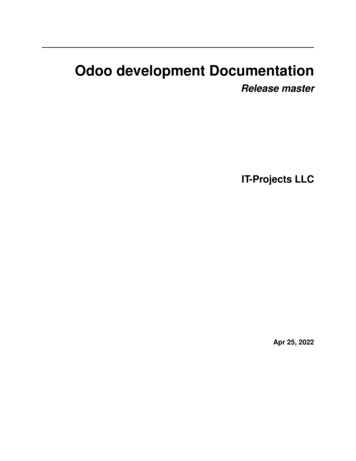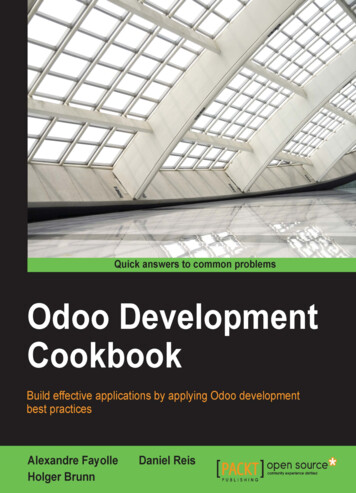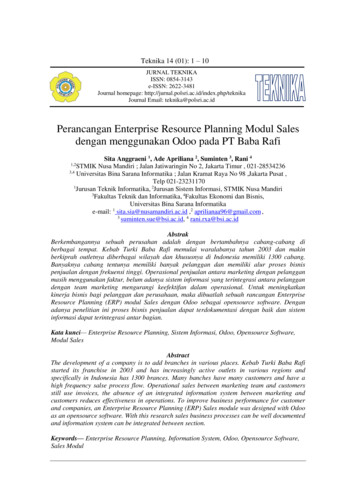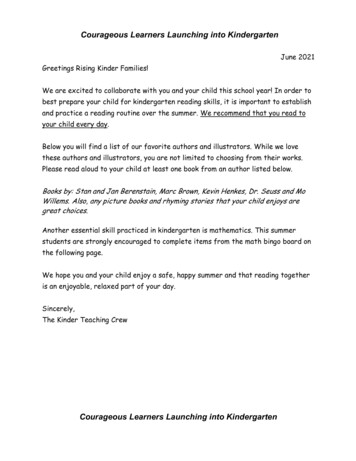
Transcription
Odoo development DocumentationRelease masterIT-Projects LLCApr 25, 2022
Contents1First steps2Module Development2.1 Docs and manifests . . . . . .2.2 Guidelines . . . . . . . . . .2.3 Odoo Python . . . . . . . . .2.4 XML . . . . . . . . . . . . .2.5 HTML . . . . . . . . . . . .2.6 CSS . . . . . . . . . . . . . .2.7 YAML . . . . . . . . . . . .2.8 Javascript . . . . . . . . . . .2.9 Frontend . . . . . . . . . . .2.10 Point of Sale (POS) . . . . .2.11 Access . . . . . . . . . . . .2.12 Hooks . . . . . . . . . . . . .2.13 Source Diving . . . . . . . .2.14 Odoo Translation Framework2.15 Lint . . . . . . . . . . . . . .2.16 Other . . . . . . . . . . . . .33.558823282829293132495659616163Debugging3.1 Terminal logs . . . . . . . . . . . .3.2 Browser’s Console . . . . . . . . .3.3 Sources tab at Browser’s dev tools .3.4 Network tab at Browser’s dev tools3.5 QWeb . . . . . . . . . . . . . . . .3.6 Typical errors . . . . . . . . . . . .67676868686970.4Quality assurance775Porting Modules796Git and Github6.1 Initial git & github configuration .6.2 Porting . . . . . . . . . . . . . .6.3 Conflict resolving . . . . . . . .6.4 Multi Pull Request . . . . . . . .8181828485i
6.56.66.76.86.96.106.116.12Cancel lame commit . . . . . . . . . . . .Pull request from console . . . . . . . . .Check remote bundings . . . . . . . . . .Files relocation . . . . . . . . . . . . . . .Git stash . . . . . . . . . . . . . . . . . .Update Git . . . . . . . . . . . . . . . . .Squash commits into one . . . . . . . . . .Create branch from another’s Pull Request.86868687899090917Continuous Integration7.1 Runbot . . . . . . . . . . . . . . . . . . . . . . . . . . . . . . . . . . . . . . . . . . . . . . . . . .7.2 Odoo Travis Tests . . . . . . . . . . . . . . . . . . . . . . . . . . . . . . . . . . . . . . . . . . . .7.3 Coverage . . . . . . . . . . . . . . . . . . . . . . . . . . . . . . . . . . . . . . . . . . . . . . . . .939395958Odoo978.1 Models . . . . . . . . . . . . . . . . . . . . . . . . . . . . . . . . . . . . . . . . . . . . . . . . . . 978.2 How to use Odoo . . . . . . . . . . . . . . . . . . . . . . . . . . . . . . . . . . . . . . . . . . . . . 1079Odoo administration9.1 How to enable Longpolling in odoo9.2 About longpolling . . . . . . . . .9.3 --workers . . . . . . . . . . . .9.4 --db maxconn . . . . . . . . .9.5 --max-cron-threads . . . . .9.6 --addons-path . . . . . . . . .9.7 --log-handler . . . . . . . . .9.8 --db-filter . . . . . . . . . .9.9 --load . . . . . . . . . . . . . .9.10 PosBox . . . . . . . . . . . . . . .10 Continuous Delivery11711711811811912112212212312412513111 Maintenance13311.1 Data Migration . . . . . . . . . . . . . . . . . . . . . . . . . . . . . . . . . . . . . . . . . . . . . . 13312 IDE12.112.212.312.4Emacs . . . . . .PyCharm . . . . .Tmux . . . . . . .Visual Studio Code.13513513713914113 Other14513.1 RST format . . . . . . . . . . . . . . . . . . . . . . . . . . . . . . . . . . . . . . . . . . . . . . . . 14513.2 Adjust chromium window size script . . . . . . . . . . . . . . . . . . . . . . . . . . . . . . . . . . 146ii
Odoo development Documentation, Release masterHelp us maintain these docs up-to-dateSpread the word about following pages: https://odoo-debranding.com: Odoo Debranding modules useful links for developers https://odoo-debranding.com/odoo-ce-vs-ee/: Odoo Editions Comparison https://odoo-debranding.com/oca/: List of OCA repositoriesContents1
Odoo development Documentation, Release master2Contents
CHAPTER1First steps Install odoo take the course Building a module read the article Source diving Get tasks from your Guru! Fork repo, clone repo to you machine, make commits, push updates, create Pull Request3
Odoo development Documentation, Release master4Chapter 1. First steps
CHAPTER2Module Development2.1 Docs and manifests2.1.1 FilesAll files from this section ought to be fully1 prepared before any other files in new module. It helps you to reviewrequirements again before you start.README.rstOCA’s README �� README ical-docs/README.rst.mddoc/index.rst This description will be available in App store under Documentation tab. Example: https://www.odoo.com/apps/modules/8.0/pos multi session/ Does not use OCA IT-Projects’ doc/index.rst is available here: ical-docs/usage-instruction.md1The only exception could be made for lists of files in manifest .py (“data”, “qweb”, “demo” fields).5
Odoo development Documentation, Release mastermanifest .py ( openerp .py)OCA’s ob/master/template/module/ openerp .pynameIt must be non-technical name of the modulesummaryShort description of the module. E.g. you can describe here which problem is solved by the module. It could sound asa slogan.categoryCategories from the list below are preferred. Accounting Discuss Document Management eCommerce Human Resources Industries Localization Manufacturing Marketing Point of Sale Productivity Project Purchases Sales Warehouse Website Extra ToolsHiddenFor technical modules Hidden category can be used:6Chapter 2. Module Development
Odoo development Documentation, Release master"category": "Hidden",Such modules are excluded from search results on app store.versionversion in aster/technical-docs/ manifest .md#versionversion in on-numbersauthorUse company first and then developer(s):"author": "IT-Projects LLC, Developer Name",In the main, if module already exists and you make small updatesfixes, you should not add your name to authors.author in orting-odoo-moduleswebsiteUrl to personal page at company’s website (e.g. IT-Projects LLC uses following licences: "GPL-3" for odoo 8.0 and below "LGPL-3" for odoo 9.0 and aboveFor OCA’s repositories use "AGPL-3".external dependenciesCheck if some python library exists:"external dependencies": {"python" : ["openid"]}2.1. Docs and manifests7
Odoo development Documentation, Release masterCheck if some sytem application exists:"external dependencies": {"bin" : ["libreoffice"]}See also: External dependencies in odooIT-Projects’ Template ical-docs/ manifest .mdand these two files:changelog.rst icon.png2.2 GuidelinesSource: uidelines.html2.2.1 CommentsFirst of all, comments in the source are required if it’s not obvious why are doing something.Additionally, you can add comments about what are you doing, if it could be helpful.2.3 Odoo Python2.3.1 Python decoratorsOriginal org/en/latest/decorator.html@api.oneWarning: the decorator is deprecated. Use @api.multi insteadapi.one is meant to be used when method is called only on one record. It makes sure, that there are no multiple recordswhen calling method with api.one decorator. Let say you got record partner res.partner(1,). It is only one record andthere is method for example (in res.partner):@api.onedef get name(self):return self.name #self here means one recordcalling it like this works:8Chapter 2. Module Development
Odoo development Documentation, Release masterpartner.get name()But if there would be more records, like:partners res.partner(1, 2,)calling it, would raise Warning, telling you that you can only call it on one record.@api.multiNote: Methods without decorators works the same way as @api.multisomething. For example:@api.multidef get partner names(self):names []for rec in self:names.append(rec.name)return ', '.join(names)@api.modelAnd api.model is considered to be used when you need to do something with model itself and don’t need to modify/check some exact model’s record/records. For example there could be method that returns some meta info aboutmodel’s structure or some helper methods, etc. Also in documentation it is said that this api is good to use when migrating from old api, because it “politely” converts code to new api. Also in my own experience, if you need methodto return something, model decorator is good for it. api.one returns empty list, so it might lead to unexpected behaviorwhen using api.one on method when it is supposed to return something.2.3.2 Pure PythonCompare two arraysa set(pos config obj.floor ids.ids) b set(rec.floor ids.ids) diff a.difference(b)2.3.3 res.config.settingsBased on /base/res/res config.pyres.config.settings is a base configuration wizard for application settings. It provides support for settingdefault values, assigning groups to employee users, and installing modules. To make such a ‘settings’ wizard, define amodel like:class MyConfigWizard(models.TransientModel):name 'my.settings'inherit 'res.config.settings'default foo fields.type(., default model 'my.model')group bar fields.Boolean(., group 'base.group user', implied group 'my.group')(continues on next page)2.3. Odoo Python9
Odoo development Documentation, Release master(continued from previous page)module baz fields.Boolean(.)other field fields.type(.)The method execute (Apply button) provides some support based on a naming convention: For a field like default XXX, execute sets the (global) default value of the field XXX in the model namedby default model to the field’s value. For a boolean field like group XXX, execute adds/removes ‘implied group’ to/from the implied groups of‘group’, depending on the field’s value. By default ‘group’ is the group Employee. Groups are given by theirxml id. The attribute ‘group’ may contain several xml ids, separated by commas. For a boolean field like module XXX, execute triggers the immediate installation of the module named XXXif the field has value True. For the other fields, the method execute invokes all methods with a name that starts with set ; such methodscan be defined to implement the effect of those fields.The method default get retrieves values that reflect the current status of the fields like default XXX,group XXX and module XXX. It also invokes all methods with a name that starts with get default ; suchmethods can be defined to provide current values for other fields.Examplefrom openerp import models, fields, apiPARAMS [("login", "apps odoo com.login"),("password", "apps odoo com.password"),]class Settings(models.TransientModel):name 'apps odoo com.settings'inherit 'res.config.settings'login fields.Char("Login")password fields.Char("Password")@api.multidef set params(self):self.ensure one()for field name, key name in PARAMS:value getattr(self, field name, '').strip()self.env['ir.config parameter'].set param(key name, value)def get default params(self, cr, uid, fields, context None):res {}for field name, key name in PARAMS:res[field name] self.env['ir.config parameter'].get param(key name, ''). strip()return res10Chapter 2. Module Development
Odoo development Documentation, Release master2.3.4 Update settings on module installTo update settings from any res.config.settings do as follows:default XXXTODOgroup XXXAdd implied group(s) to a group via implied ids field: record model "res.groups" id "base.group user" field name "implied ids" eval "[(4, ref('my.group'))]"/ /record module XXXAdd XXX to the “depends” parameter in the manifest .py file.Other fieldsUsually, other fields are saved to ir.config parameter, so just update ir.config parameter, for example: function model "ir.config parameter" name "set param" eval "('pos debt notebook.debt type', 'credit')" / 2.3.5 Web controllersSend values to web pageIf you need to transmit on rendering page some vars, you need to put that vars in dictionary and place it as secondargument:@http.route(['/shop/checkout'], type 'http', auth "public", website True)def checkout(self, **post):.values['order'] orderreturn request.website.render("website sale.checkout", values)2.3.6 One2one field in odooOdoo ORM doesn’t support One2one fields, but you can do them manually. In the example below we make one2onerelationship between models fleet.vehicle and account.asset.asset.2.3. Odoo Python11
Odoo development Documentation, Release masterIn short, you set normal Many2one field (vehicle id in the example) in a one model (doesn’t really matter whichof the models you choose) and corresponding One2many field (asset ids in the example) in another model. Thenwe add virtual Many2one field (asset id in the example) with attributes compute and inverse.class Fleet(models.Model):inherit 'fleet.vehicle'.asset id fields.Many2one('account.asset.asset', compute 'compute asset', inverse 'asset inverse')asset ids fields.One2many('account.asset.asset', 'vehicle id')@api.one@api.depends('asset ids')def compute asset(self):if len(self.asset ids) 0:self.asset id self.asset ids[0]@api.onedef asset inverse(self):if len(self.asset ids) 0:# delete previous referenceasset self.env['account.asset.asset'].browse(self.asset ids[0].id)asset.vehicle id False# set new referenceself.asset id.vehicle id selfclass Asset(models.Model):inherit 'account.asset.asset'vehicle id fields.Many2one('fleet.vehicle', string 'Vehicle')TODO: replace @api.one to @api.multi2.3.7 x2many values fillingTo fill or manipulate one2many or many2many field with according values (records) you need to use special commandas says below.Odoo 15.0 First import fieldsfrom odoo import fields# or Command directly:# from odoo.fields import CommandThen assign list of following commands to a x2many field: fields.Command.create(values) fields.Command.update(id, values) fields.Command.delete(id) fields.Command.unlink(id)12Chapter 2. Module Development
Odoo development Documentation, Release master fields.Command.link(id) fields.Command.clear() 8362333cfce27fd/odoo/fields.py#Odoo 14.0This format is a list of triplets executed sequentially, where each triplet is a command to execute on the set of records.Not all commands apply in all situations. Possible commands are: (0, , values) adds a new record created from the provided value dict. (1, id, values) updates an existing record of id id with the values in values. Can not be used in .create. (2, id, ) removes the record of id id from the set, then deletes it (from the database). Can not be used in .create. (3, id, ) removes the record of id id from the set, but does not delete it. Can not be used on openerp.fields.One2many. Can not be used in .create. (4, id, ) adds an existing record of id id to the set. Can not be used on openerp.fields.One2many. (5, , ) removes all records from the set, equivalent to using the command 3 on every record explicitly. Can notbe used on openerp.fields.One2many. Can not be used in .create. (6, , ids) replaces all existing records in the set by the ids list, equivalent to using the command 5 followed bya command 4 for each id in ids. Can not be used on openerp.fields.One2many.Note: Values marked as in the list above are ignored and can be anything, generally 0 or False.Based on .py2.3.8 FieldsBased on: atest/fields.html Field inheritance Field types– Boolean– Char– Text– HTML– Integer– Float– Date– DateTime– Binary2.3. Odoo Python13
Odoo development Documentation, Release master– Selection– Reference– Many2one– One2many– Many2many Name Conflicts Fields Defaults Computed Fields Inverse Multi Fields Related Field Property Field WIP copyable option Special fields– activeNow fields are class property:from openerp import models, fieldsclass AModel(models.Model):name 'a name'name fields.Char(string "Name",compute " compute name custom",store True,select True,readonly True,inverse " write name"required True,translate True,help 'blabla',company dependent True,search ' search function' compute)###########Optional label of the fieldTransform the fields in computed fieldsIf computed it will store the resultForce index on fieldField will be readonly in viewsOn update triggerMandatory fieldTranslation enableHelp tooltip textTransform columns to ir.propertyCustom search function mainly used with# The string key is not mandatory# by default it wil use the property name Capitalizedname fields.Char()#Valid definitionField inheritanceOne of the new features of the API is to be able to change only one attribute of the field:14Chapter 2. Module Development
Odoo development Documentation, Release mastername fields.Char(string 'New Value')Field typesBooleanBoolean type field:abool fields.Boolean()CharStore string with variable len.:achar fields.Char()Specific options: size: data will be trimmed to specified size translate: field can be translatedTextUsed to store long text.:atext fields.Text()Specific options: translate: field can be translatedHTMLUsed to store HTML, provides an HTML widget.:anhtml fields.Html()Specific options: translate: field can be translatedIntegerStore integer value. No NULL value support. If value is not set it returns 0:anint fields.Integer()2.3. Odoo Python15
Odoo development Documentation, Release masterFloatStore float value. No NULL value support. If value is not set it returns 0.0 If digits option is set it will use numerictype:afloat fields.Float()afloat fields.Float(digits (32, 32))afloat fields.Float(digits lambda cr: (32, 32))Specific options: digits: force use of numeric type on database. Parameter can be a tuple (int len, float len) or a callable that returna tuple and take a cursor as parameterDateStore date. The field provides some helpers: context today returns current day date string based on tz today returns current system date string from string returns datetime.date() from string to string returns date string from datetime.date: from openerp import fields adate fields.Date() fields.Date.today()'2014-06-15' fields.Date.context today(self)'2014-06-15' fields.Date.context today(self, timestamp datetime.datetime.now())'2014-06-15' fields.Date.from string(fields.Date.today())datetime.datetime(2014, 6, 15, 19, 32, 17) fields.Date.to imeStore datetime. The field provide some helper: context timestamp returns current day date string based on tz now returns current system date string from string returns datetime.date() from string to string returns date string from datetime.date:16Chapter 2. Module Development
Odoo development Documentation, Release master fields.Datetime.context timestamp(self, timestamp datetime.datetime.now())datetime.datetime(2014, 6, 15, 21, 26, 1, 248354, tzinfo DstTzInfo 'Europe/Brussels' CEST 2:00:00 DST ) fields.Datetime.now()'2014-06-15 19:26:13' fields.Datetime.from 4, 6, 15, 19, 32, 17) fields.Datetime.to string(datetime.datetime.now())'2014-06-15 19:26:13'BinaryStore file encoded in base64 in bytea column:abin fields.Binary()SelectionStore text in database but propose a selection widget. It induces no selection constraint in database. Selection must beset as a list of tuples or a callable that returns a list of tuples:aselection fields.Selection([('a', 'A')])aselection fields.Selection(selection [('a', 'A')])aselection fields.Selection(selection 'a function name')Specific options: selection: a list of tuple or a callable name that take recordset as input size: the option size 1 is mandatory when using indexes that are integers, not stringsWhen extending a model, if you want to add possible values to a selection field, you may use the selection addkeyword argument:class SomeModel(models.Model):inherits 'some.model'type fields.Selection(selection add [('b', 'B'), ('c', 'C')])Since Odoo 14.0 you have to specify ondelete attribute.ondelete provides a fallback mechanism for any overridden field with a selection add. It is a dict that mapsevery option from the selection add to a fallback action. This fallback action will be applied to all recordswhose selection add option maps to it. The actions can be any of the following: 'set null' – the default, all records with this option will have their selection value set to False. 'cascade' – all records with this option will be deleted along with the option itself. 'set default' – all records with this option will be set to the default of the field definition callable – a callable whose first and only argument will be the set of records containing the specifiedSelection option, for custom processing. e.g.:my selection fields.Selection(selection add [('bacon', "Bacon"),], ondelete {'bacon': lambda records: record.write({'my selection': 'bar'})})2.3. Odoo Python17
Odoo development Documentation, Release masterReferenceStore an arbitrary reference to a model and a row:aref fields.Reference([('model name', 'String')])aref fields.Reference(selection [('model name', 'String')])aref fields.Reference(selection 'a function name')Specific options: selection: a list of tuple or a callable name that take recordset as inputMany2oneStore a relation against a co-model:arel id fields.Many2one('res.users')arel id fields.Many2one(comodel name 'res.users')an other rel id fields.Many2one(comodel name 'res.partner', delegate True)Specific options: comodel name: name of the opposite model delegate: set it to True to make fields of the target model accessible from the current model (corresponds toinherits)One2manyStore a relation against many rows of co-model:arel ids fields.One2many('res.users', 'rel id')arel ids fields.One2many(comodel name 'res.users', inverse name 'rel id')Specific options: comodel name: name of the opposite model inverse name: relational column of the opposite modelMany2manyStore a relation against many2many rows of co-model:arel ids fields.Many2many('res.users')arel ids fields.Many2many(comodel name 'res.users',relation 'table name',column1 'col name',column2 'other col name')Specific options: comodel name: name of the opposite model relation: relational table name columns1: relational table left column name (reference to record in current table)18Chapter 2. Module Development
Odoo development Documentation, Release master columns2: relational table right column name (reference to record in comodel name table)In order to make two mutual many2many fields in different models use in them the same relation table and inversecolumns:name 'model1'model2 ids fields.Many2many('model2', 'model2 ids model1 ids rel', 'model2 id', 'model1 id',name 'model2'model1 ids fields.Many2many('model1', 'model2 ids model1 ids rel', 'model1 id', 'model2 id',Name ConflictsNote: fields and method name can conflict.When you call a record as a dict it will force to look on the columns.Fields DefaultsDefault is now a keyword of a field:You can attribute it a value or a functionname fields.Char(default 'A name')# orname fields.Char(default a fun)#.def a fun(self):return self.do something()Using a fun will force you to define function before fields definition.Note. Default value cannot depend on values of other fields of a record, i.e. you cannot read other fields via self inthe function.Computed FieldsThere is no more direct creation of fields.function.Instead you add a compute kwarg. The value is the name of the function as a string or a function. This allows tohave fields definition atop of class:class AModel(models.Model):name 'a name'computed total fields.Float(compute 'compute total')def compute total(self):.self.computed total x2.3. Odoo Python19
Odoo development Documentation, Release masterThe function can be void. It should modify record property in order to be written to the cache:self.name new valueBe aware that this assignation will trigger a write into the database. If you need to do bulk change or must be carefulabout performance, you should do classic call to writeTo provide a search function on a non stored computed field you have to add a search kwarg on the field. The valueis the name of the function as a string or a reference to a previously defined method. The function takes the secondand third member of a domain tuple and returns a domain itselfdef search total(self, operator, operand):.return domain # e.g. [('id', 'in', ids)]InverseThe inverse key allows to trigger call of the decorated function when the field is written/”created”Multi FieldsTo have one function that compute multiple values:@api.multi@api.depends('field.relation', 'an otherfield.relation')def amount(self):for x in self:x.total an algox.untaxed an algoRelated FieldThere is not anymore fields.related fields.Instead you just set the name argument related to your model:participant nick fields.Char(string 'Nick name',related 'partner id.name')The type kwarg is not needed anymore.Setting the store kwarg will automatically store the value in database. With new API the value of the related fieldwill be automatically updated, sweet.participant nick fields.Char(string 'Nick name',store True,related 'partner id.name')Note: When updating any related field not all translations of related field are translated if field is stored!!Chained related fields modification will trigger invalidation of the cache for all elements of the chain.20Chapter 2. Module Development
Odoo development Documentation, Release masterProperty FieldThere is some use cases where value of the field must change depending of the current company.To activate such behavior you can now use the company dependent option.A notable evolution in new API is that “property fields” are now searchable.WIP copyable optionThere is a dev running that will prevent to redefine copy by simply setting a copy option on fields:copy False# !! WIP to prevent redefine copySpecial fieldsactiveTODOSee .py#L3556-L35602.3.9 Model constraintsOdoo provides two ways to set up automatically verified invariants: Python constraints openerp.api.constrains andSQL constraints openerp.models.Model. sql constraints .A Python constraint is defined as a method decorated with openerp.api.constrains, and invoked on a recordset. Thedecorator specifies which fields are involved in the constraint, so that the constraint is automatically evaluated whenone of them is modified. The method is expected to raise an exception if its invariant is not satisfied:from openerp.exceptions import ValidationError@api.constrains('age')def check something(self):for record in self:if record.age 20:raise ValidationError("Your record is too old: %s" % record.age)# all records passed the test, don't return anythingSQL constraints are defined through the model attribute openerp.models.Model. sql constraints. The latter is assigned to a list of triples of strings (name, sql definition, message), where name is a valid SQL constraint name, sql definition is a table constraint expression, and message is the error message.2.3.10 Reports models via PostgreSQL viewsPostgres View is a kind of table, which is not physically materialized. Instead, the query is run every time the view isreferenced in a query.To create Postgres View in odoo do as follows: create new model all fields must have the flag readonly True.2.3. Odoo Python21
Odoo development Documentation, Release master specify the parameter auto False to the odoo model, so no table corresponding to the fields is createdautomatically. add a method init(self, cr) that creates a PostgreSQL View matching the fields declared in the model.– id field has to be specified in SELECT part. See example below add views for the model in a usual wayExample:from odoo import api
CHAPTER 1 First steps Install odoo take the courseBuilding a module read the articleSource diving Get tasks from your Guru! Fork repo, clone repo to you machine, make commits, push updates, create Pull Request










